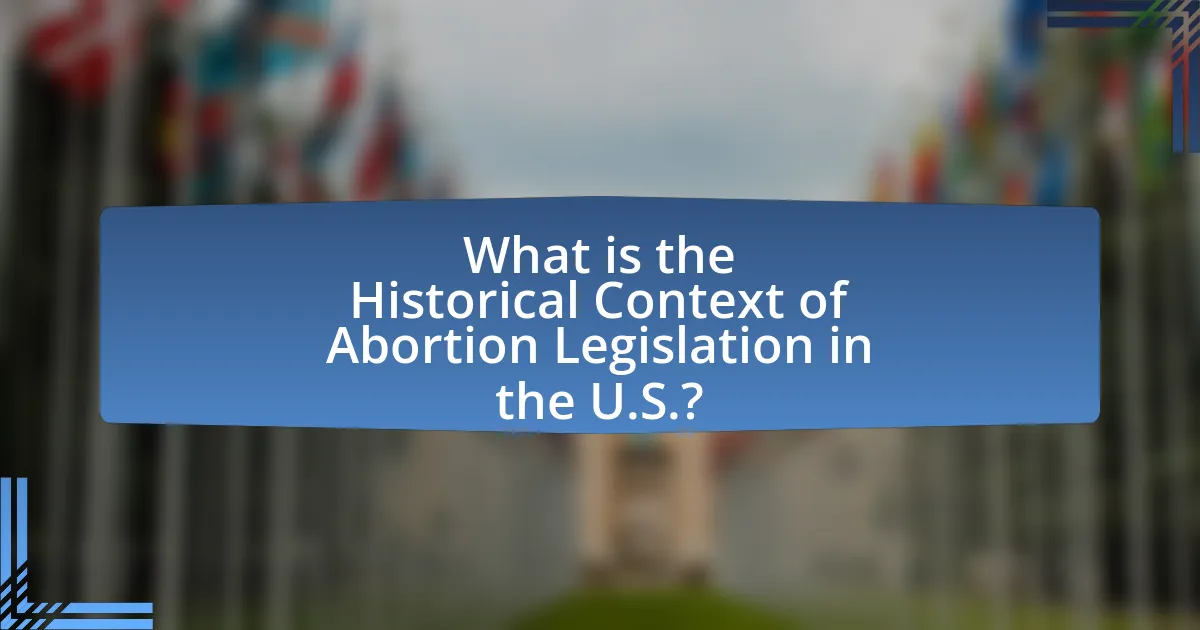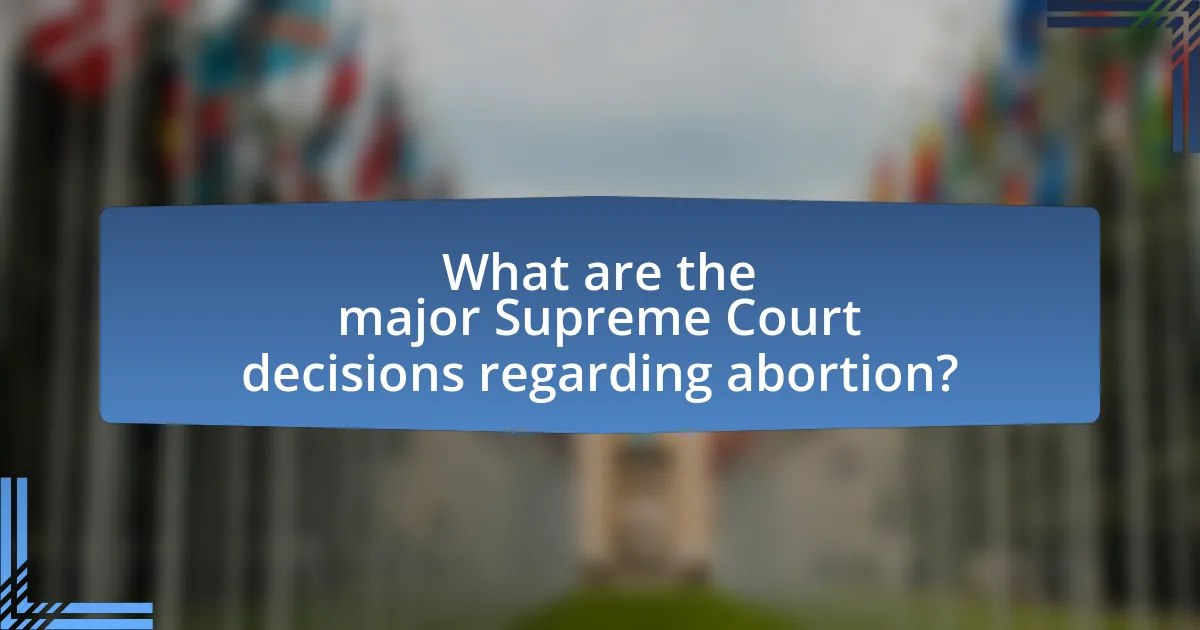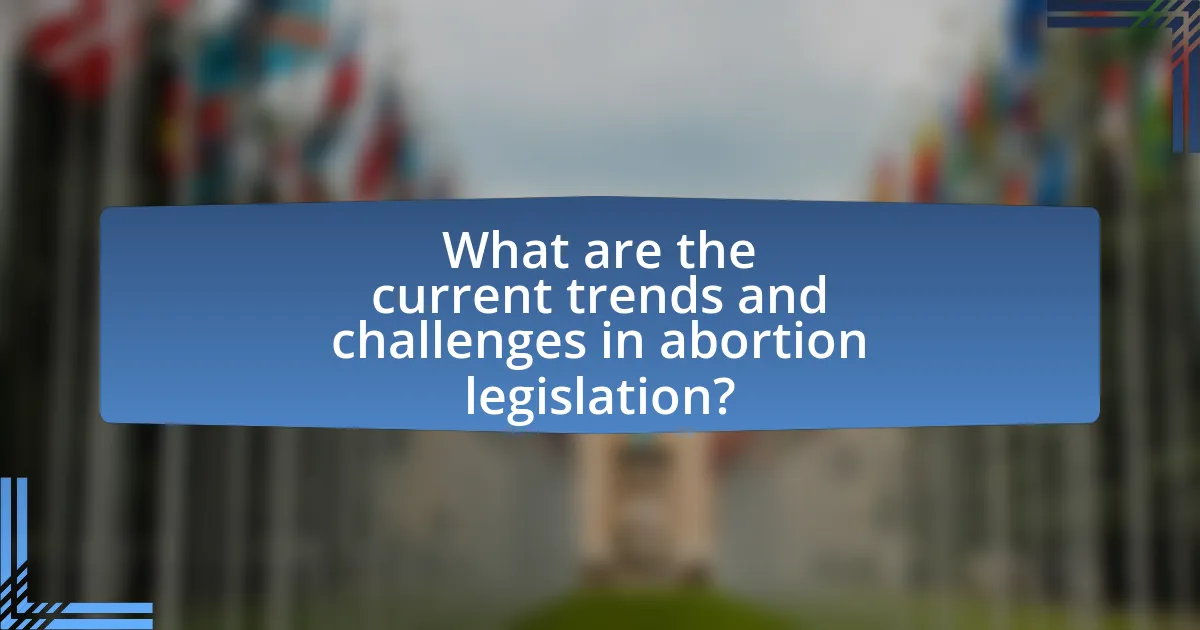The article examines the historical context of abortion legislation in the United States, detailing its evolution from the largely unregulated practices of the early 19th century to the landmark Supreme Court decisions that shaped reproductive rights. Key milestones include the 1973 Roe v. Wade ruling, which established a constitutional right to abortion, and the subsequent Planned Parenthood v. Casey and Dobbs v. Jackson Women’s Health Organization cases that influenced state regulations. The article also explores the impact of societal attitudes, early American laws, and the women’s rights movement on abortion legislation, highlighting current trends and challenges in access to abortion services across different states.

What is the Historical Context of Abortion Legislation in the U.S.?
The historical context of abortion legislation in the U.S. reveals a complex evolution influenced by social, legal, and political factors. Initially, abortion was largely unregulated in the early 19th century, with many states allowing it until “quickening,” or the first noticeable fetal movements. However, by the late 1800s, a wave of anti-abortion laws emerged, driven by medical professionals and moral reformers, leading to widespread criminalization by the early 20th century.
The landmark Supreme Court case Roe v. Wade in 1973 marked a significant turning point, as the Court ruled that the right to privacy under the Due Process Clause of the 14th Amendment extended to a woman’s decision to have an abortion. This decision effectively legalized abortion nationwide, but it also sparked ongoing debates and legislative efforts to restrict access, particularly in the 1980s and 1990s, with various states enacting laws aimed at limiting abortion rights.
In recent years, the historical context has continued to evolve, with significant challenges to Roe v. Wade, culminating in the Supreme Court’s decision in Dobbs v. Jackson Women’s Health Organization in 2022, which overturned Roe and returned the authority to regulate abortion to individual states. This shift has led to a patchwork of laws across the country, reflecting the ongoing contentious nature of abortion legislation in the U.S.
How has abortion legislation evolved throughout U.S. history?
Abortion legislation in the U.S. has evolved significantly from the 19th century to the present day. Initially, most states had laws that allowed abortion only to save the life of the mother, reflecting societal norms and medical practices of the time. The landmark case of Roe v. Wade in 1973 established a woman’s legal right to choose abortion under the constitutional right to privacy, effectively invalidating many state laws that restricted access. Following Roe, various states enacted laws to regulate abortion, leading to ongoing legal battles and changes in access. In 2022, the Supreme Court’s decision in Dobbs v. Jackson Women’s Health Organization overturned Roe, allowing states to set their own abortion laws, resulting in a patchwork of regulations across the country. This evolution reflects changing societal attitudes, legal interpretations, and political dynamics surrounding reproductive rights in the U.S.
What were the key legal milestones in the history of abortion laws?
The key legal milestones in the history of abortion laws in the U.S. include the 1973 Supreme Court decision in Roe v. Wade, which established a woman’s legal right to abortion under the right to privacy, and the 1992 case of Planned Parenthood v. Casey, which upheld Roe v. Wade while allowing states to impose certain restrictions. Additionally, the 2000 Supreme Court ruling in Stenberg v. Carhart struck down a Nebraska law banning partial-birth abortion, reinforcing the protections established in Roe. These cases collectively shaped the legal landscape of abortion rights in the United States, influencing subsequent legislation and court rulings.
How did societal attitudes towards abortion influence legislation?
Societal attitudes towards abortion significantly influenced legislation by shaping public opinion and political discourse, leading to changes in laws and regulations. For instance, the shift in attitudes during the women’s rights movement in the 1960s and 1970s prompted lawmakers to reconsider restrictive abortion laws, culminating in the landmark Supreme Court decision of Roe v. Wade in 1973, which legalized abortion nationwide. This decision reflected the growing acceptance of women’s autonomy over their reproductive choices, as evidenced by public opinion polls at the time showing increasing support for legal abortion. Additionally, subsequent societal debates and movements, such as the pro-life and pro-choice movements, have continued to impact legislative actions at both state and federal levels, resulting in a patchwork of laws that reflect varying societal attitudes across different regions.
What role did early American laws play in shaping abortion legislation?
Early American laws significantly influenced the development of abortion legislation by establishing legal precedents and societal norms regarding reproductive rights. In the 19th century, many states enacted laws that criminalized abortion, reflecting prevailing moral views and concerns about women’s health. For instance, the 1821 Connecticut law was one of the first to explicitly prohibit abortion after quickening, indicating a shift towards regulating women’s reproductive choices. These early legal frameworks laid the groundwork for later debates and legislation, as they shaped public perception and legal interpretations of abortion rights throughout American history.
What were the common practices regarding abortion in colonial America?
Common practices regarding abortion in colonial America included the use of herbal remedies and physical methods to induce miscarriage. Women often relied on midwives or local healers for assistance, utilizing plants like pennyroyal and other herbs believed to have abortifacient properties. Legal and societal views on abortion varied, but it was generally tolerated in early pregnancy, particularly before “quickening,” the point at which fetal movement is felt, typically around 16 to 20 weeks. Historical records indicate that while abortion was not openly discussed, it was practiced discreetly, reflecting a complex interplay of cultural, religious, and medical beliefs during that period.
How did the introduction of the Comstock Act affect abortion laws?
The introduction of the Comstock Act in 1873 significantly restricted abortion laws by criminalizing the distribution of contraceptives and information about abortion. This federal legislation categorized abortion as obscene, leading to increased legal penalties for those involved in providing abortion services or information. The Act’s enforcement resulted in a decline in access to safe abortion methods and contributed to the stigmatization of reproductive health discussions, effectively pushing abortion practices underground and limiting women’s autonomy over their reproductive choices.
What impact did the women’s rights movement have on abortion legislation?
The women’s rights movement significantly influenced abortion legislation by advocating for women’s autonomy over their reproductive choices. This movement, particularly during the 1960s and 1970s, led to increased public awareness and support for reproductive rights, culminating in the landmark Supreme Court decision in Roe v. Wade in 1973, which legalized abortion nationwide. The activism of organizations such as the National Organization for Women and grassroots campaigns highlighted the need for safe and legal abortion access, thereby shaping legislative changes and public policy regarding reproductive health.
How did the feminist movement of the 1960s and 1970s advocate for abortion rights?
The feminist movement of the 1960s and 1970s advocated for abortion rights primarily through grassroots organizing, legal challenges, and public awareness campaigns. Activists emphasized women’s autonomy over their bodies and reproductive choices, arguing that access to safe and legal abortion was essential for gender equality. Organizations such as the National Organization for Women (NOW) and the Feminist Women’s Health Center played pivotal roles in mobilizing support and providing education on reproductive health. Landmark events, including the 1970 Women’s Strike for Equality, highlighted the demand for reproductive rights, while legal cases like Roe v. Wade in 1973 established a constitutional right to abortion, reflecting the movement’s influence on public policy and societal attitudes.
What were the significant court cases that emerged from this movement?
The significant court cases that emerged from the movement for abortion rights in the U.S. include Roe v. Wade (1973), Planned Parenthood v. Casey (1992), and Whole Woman’s Health v. Hellerstedt (2016). Roe v. Wade established a woman’s legal right to have an abortion under the right to privacy, fundamentally shaping abortion law in the United States. Planned Parenthood v. Casey reaffirmed Roe’s core holding while allowing states to impose certain restrictions, as long as they did not place an “undue burden” on women seeking abortions. Whole Woman’s Health v. Hellerstedt further clarified the undue burden standard by striking down Texas regulations that imposed strict requirements on abortion clinics, emphasizing that such regulations must have a legitimate health benefit. These cases collectively illustrate the evolving legal landscape surrounding abortion rights in the U.S.

What are the major Supreme Court decisions regarding abortion?
The major Supreme Court decisions regarding abortion include Roe v. Wade (1973), Planned Parenthood v. Casey (1992), and Dobbs v. Jackson Women’s Health Organization (2022). Roe v. Wade established a woman’s legal right to have an abortion under the right to privacy, effectively legalizing abortion nationwide. Planned Parenthood v. Casey reaffirmed Roe’s core holding but allowed states to impose certain restrictions, provided they did not place an “undue burden” on a woman’s right to choose. Dobbs v. Jackson Women’s Health Organization overturned Roe v. Wade, returning the authority to regulate abortion to individual states, thus significantly altering the legal landscape surrounding abortion rights in the United States.
How did Roe v. Wade change the landscape of abortion rights?
Roe v. Wade fundamentally transformed abortion rights in the United States by establishing a constitutional right to privacy that encompasses a woman’s decision to terminate her pregnancy. This landmark 1973 Supreme Court decision invalidated many state laws that restricted access to abortion, effectively legalizing the procedure nationwide during the first trimester and setting a framework for subsequent regulations. The ruling led to significant shifts in public policy and societal attitudes towards abortion, prompting a national debate that continues to influence legislation and judicial decisions related to reproductive rights.
What were the arguments presented in Roe v. Wade?
The arguments presented in Roe v. Wade centered around the right to privacy and the state’s interest in regulating abortions. The plaintiff, Roe, argued that the Texas laws criminalizing most abortions violated her constitutional right to privacy under the Due Process Clause of the Fourteenth Amendment. The Supreme Court, in its 1973 decision, recognized that the right to privacy encompasses a woman’s decision to terminate her pregnancy, while also acknowledging the state’s interests in protecting maternal health and potential human life. This balancing of rights and interests formed the basis of the Court’s ruling, which ultimately established a framework for abortion regulation based on the trimester of pregnancy.
What implications did Roe v. Wade have on state laws?
Roe v. Wade established a constitutional right to abortion, significantly limiting states’ ability to regulate the procedure. The Supreme Court’s decision in 1973 ruled that states could not impose excessive restrictions on abortion access during the first trimester, thereby invalidating many existing state laws that sought to ban or heavily regulate abortions. This ruling led to a wave of legal challenges and changes in state laws, as states had to align their regulations with the federal standard set by the Court. Consequently, many states enacted laws that either protected or restricted access to abortion, reflecting the ongoing national debate over reproductive rights.
What subsequent cases have influenced abortion legislation post-Roe v. Wade?
Subsequent cases that have influenced abortion legislation post-Roe v. Wade include Planned Parenthood v. Casey (1992), which upheld the core holding of Roe while allowing states to impose certain restrictions, and Whole Woman’s Health v. Hellerstedt (2016), which struck down Texas regulations that created undue burdens on women seeking abortions. Planned Parenthood v. Casey reaffirmed the right to abortion but permitted states to regulate the procedure, leading to a patchwork of state laws. Whole Woman’s Health v. Hellerstedt emphasized the necessity of evaluating the impact of state laws on women’s access to abortion services, reinforcing the standard that laws cannot place an undue burden on the right to choose. These cases have shaped the legal landscape surrounding abortion rights in the United States.
How did Planned Parenthood v. Casey modify the standards set by Roe v. Wade?
Planned Parenthood v. Casey modified the standards set by Roe v. Wade by affirming the constitutional right to have an abortion while allowing states to impose certain restrictions. The 1992 Supreme Court decision upheld the core holding of Roe, which recognized a woman’s right to choose, but introduced the “undue burden” standard, stating that any state law imposing significant obstacles before fetal viability is unconstitutional. This ruling permitted states to implement regulations such as waiting periods and parental consent laws, as long as they did not place an undue burden on a woman’s right to access abortion services. The decision thus balanced the state’s interests in regulating abortions with the rights established in Roe, reshaping the legal landscape of abortion rights in the United States.
What role did Whole Woman’s Health v. Hellerstedt play in shaping access to abortion?
Whole Woman’s Health v. Hellerstedt significantly shaped access to abortion by striking down Texas laws that imposed strict regulations on abortion clinics, which were deemed unconstitutional. The Supreme Court ruled in 2016 that these regulations created an undue burden on women seeking abortions, thereby reinforcing the precedent set in Roe v. Wade. The decision highlighted that the state cannot impose unnecessary health regulations that limit access to abortion services without providing substantial medical benefits, thus ensuring that women retain their right to access safe and legal abortion care.

What are the current trends and challenges in abortion legislation?
Current trends in abortion legislation include increased restrictions in several U.S. states, particularly following the Supreme Court’s decision to overturn Roe v. Wade in 2022, which has led to a patchwork of laws varying significantly by state. Challenges include legal battles over state laws, access to abortion services, and the ongoing debate about reproductive rights, with many states enacting laws that impose waiting periods, mandatory counseling, and limitations on when abortions can be performed. For instance, as of 2023, over 20 states have implemented near-total bans or significant restrictions on abortion, while others have moved to protect access, reflecting a divided national landscape.
How have recent state laws impacted access to abortion services?
Recent state laws have significantly restricted access to abortion services across the United States. For instance, numerous states have enacted laws imposing gestational limits, mandatory waiting periods, and increased regulations on clinics, which have led to the closure of many facilities. According to the Guttmacher Institute, as of 2023, over 30 states have implemented laws that severely limit or ban abortions, resulting in reduced availability of services, particularly in southern and midwestern regions. These legislative changes have created barriers for individuals seeking abortions, including increased travel distances and costs, ultimately impacting their ability to access necessary healthcare.
What are the most common restrictions imposed by states on abortion access?
The most common restrictions imposed by states on abortion access include mandatory waiting periods, parental consent or notification laws, gestational limits, and mandatory counseling requirements. Mandatory waiting periods require individuals to wait a specified time, often 24 to 72 hours, before obtaining an abortion, which can delay access. Parental consent or notification laws mandate that minors obtain permission from a parent or guardian, impacting their ability to access services. Gestational limits restrict abortions after a certain number of weeks, commonly around 20 weeks, based on fetal viability arguments. Mandatory counseling requirements often involve providing information designed to dissuade individuals from proceeding with the abortion, which can create additional barriers. These restrictions have been enacted in various states, reflecting ongoing debates over abortion rights and access in the U.S.
How do these restrictions vary across different states?
Abortion restrictions vary significantly across different states in the U.S., with some states implementing stringent laws while others maintain more liberal access. For instance, states like Texas and Alabama have enacted laws that impose strict gestational limits and require mandatory waiting periods, while states such as California and New York have fewer restrictions, allowing for abortion up to viability and beyond in certain circumstances. According to the Guttmacher Institute, as of 2023, 13 states have enacted total bans on abortion, while 16 states have laws protecting access to abortion services. This disparity reflects the political, cultural, and social attitudes towards abortion in each state, influencing the legislative landscape and access to reproductive healthcare.
What are the implications of the changing political landscape on abortion legislation?
The changing political landscape significantly impacts abortion legislation by shifting the balance of power between pro-choice and pro-life advocates. For instance, the 2022 Supreme Court decision in Dobbs v. Jackson Women’s Health Organization overturned Roe v. Wade, allowing states to implement stricter abortion laws, which has led to a patchwork of regulations across the country. As a result, states with conservative leadership have enacted laws that severely restrict access to abortion, while more liberal states have moved to protect and expand abortion rights. This polarization reflects broader political trends, where party affiliation increasingly dictates positions on reproductive rights, influencing public policy and access to healthcare services.
How do political parties influence abortion rights and legislation?
Political parties significantly influence abortion rights and legislation through their platforms, policy proposals, and legislative actions. For instance, the Democratic Party generally supports abortion rights, advocating for access to reproductive healthcare and opposing restrictive laws, while the Republican Party often seeks to limit abortion access, promoting legislation that imposes restrictions or bans on the procedure. This influence is evident in the passage of laws such as the Hyde Amendment, which restricts federal funding for abortions, largely supported by Republican lawmakers. Additionally, party control over state legislatures has led to various state-level restrictions, with Republican-led states enacting laws that challenge Roe v. Wade, while Democratic-led states have moved to protect and expand abortion rights.
What role does public opinion play in shaping abortion laws today?
Public opinion significantly influences the shaping of abortion laws today, as lawmakers often respond to the prevailing views of their constituents. For instance, a Gallup poll from May 2023 indicated that 55% of Americans identified as pro-choice, reflecting a majority that can sway legislative decisions. This public sentiment has led to various states enacting laws that align with the majority opinion, such as the expansion of access to abortion services in states like California and New York, while other states have implemented restrictive measures in response to differing local views. The dynamic between public opinion and legislative action demonstrates how societal attitudes directly impact the legal landscape surrounding abortion in the U.S.
What practical steps can individuals take to stay informed about abortion legislation?
Individuals can stay informed about abortion legislation by regularly following reputable news sources, subscribing to newsletters from advocacy organizations, and engaging with local community groups focused on reproductive rights. Reputable news sources such as The New York Times and NPR provide ongoing coverage and analysis of legislative changes. Advocacy organizations like Planned Parenthood and the Guttmacher Institute offer newsletters that summarize key developments and provide educational resources. Additionally, local community groups often host events and discussions that can provide insights into state-specific legislation and mobilization efforts. These steps ensure individuals receive accurate and timely information regarding the evolving landscape of abortion laws in the U.S.
How can individuals engage in advocacy for reproductive rights?
Individuals can engage in advocacy for reproductive rights by participating in grassroots organizing, lobbying for policy changes, and educating their communities about reproductive health issues. Grassroots organizing involves mobilizing local communities to raise awareness and support for reproductive rights, often through events, campaigns, and social media outreach. Lobbying for policy changes includes contacting legislators, attending town hall meetings, and advocating for specific legislation that protects reproductive rights, such as access to abortion and contraception. Education efforts can take the form of workshops, informational sessions, and distributing literature that informs the public about reproductive health and rights, which is crucial given that 70% of Americans support legal access to abortion according to a 2022 Gallup poll.
What resources are available for understanding current abortion laws?
Comprehensive resources for understanding current abortion laws include government websites, legal databases, and advocacy organizations. Websites such as the Guttmacher Institute provide detailed analyses and updates on state and federal abortion laws, while the American Civil Liberties Union (ACLU) offers insights into legal challenges and rights related to abortion. Additionally, legal databases like Westlaw and LexisNexis contain extensive case law and statutes regarding abortion legislation. These resources are essential for obtaining accurate and up-to-date information on the evolving landscape of abortion laws in the U.S.

